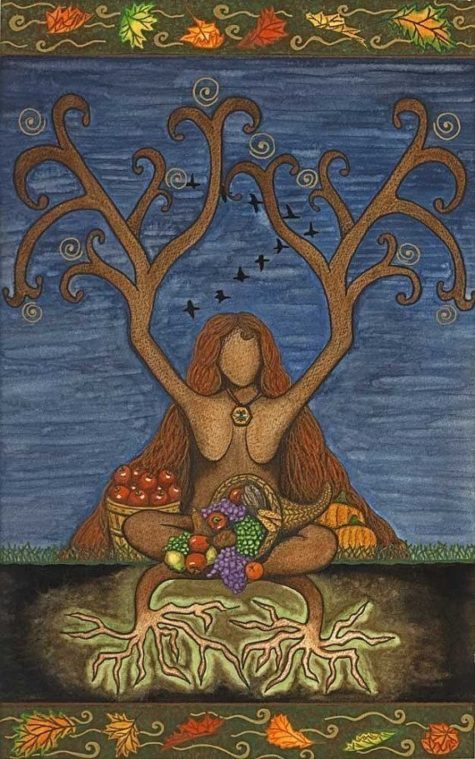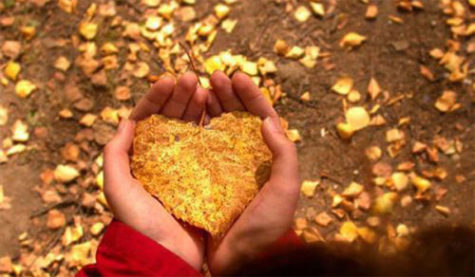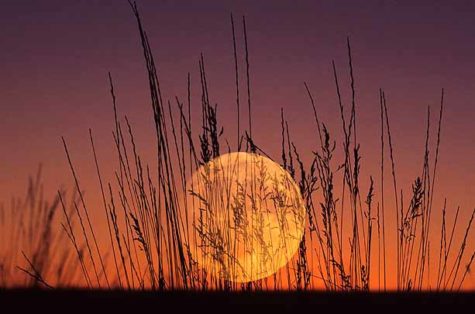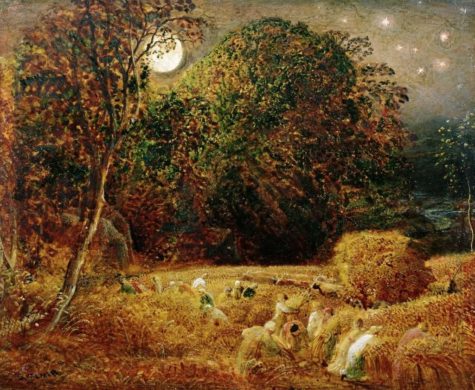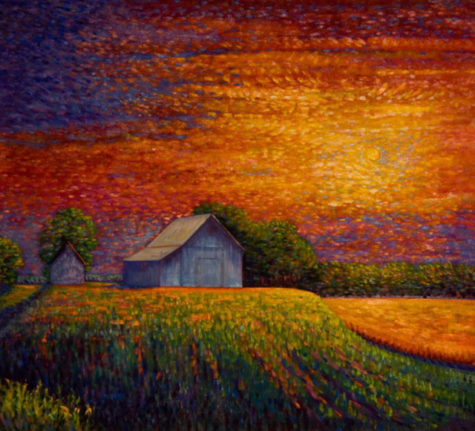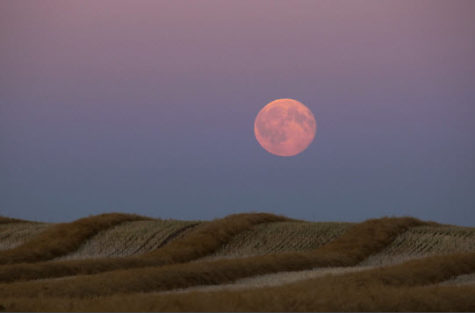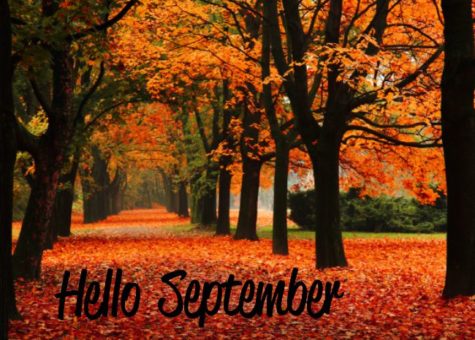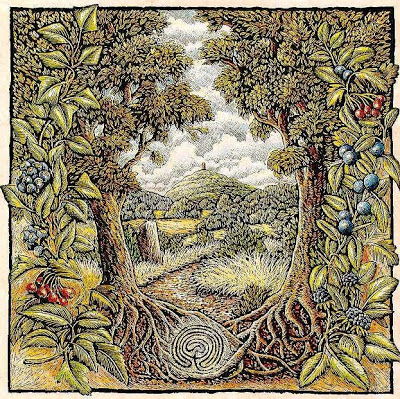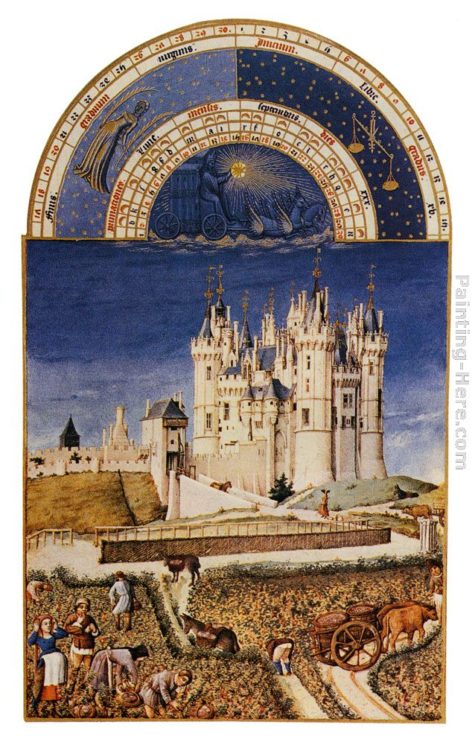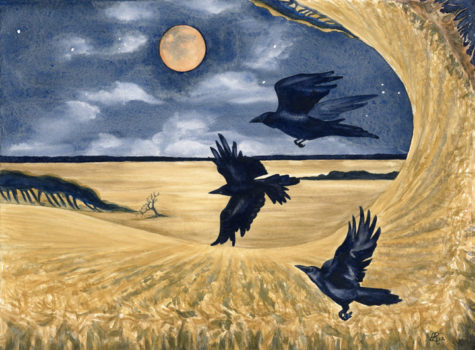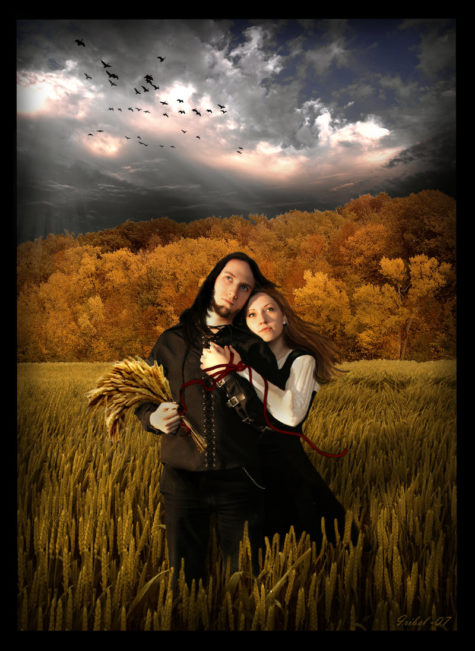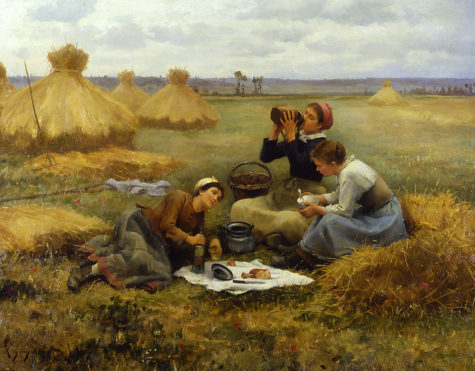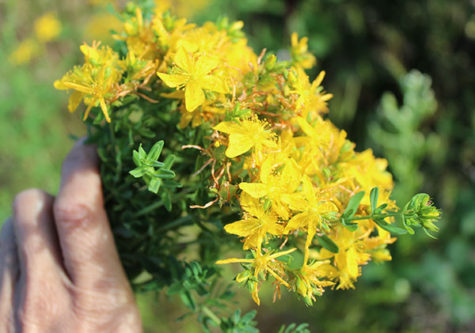Harvest
The Autumnal Equinox festival is known in some traditions as Cuivanya or the Feast of Divine Life. This particular version of this celebration of the Autumnal Equinox is a holy day in the Filanic tradition.
- What is Filanism?
Filianism (the “Daughter Tradition” – from filia,daughter) is a religion that is sometimes considered to have started, or taken its current specific form, in the 1970s, since that is when it first became publicly known. Its first recorded modern appearances were in Britain, although some have postulated a Greek or Asian origin for its Scriptures and philosophy.
It is one of the four Cardinal Feasts of the year, and stands at the center of both the Mysteries of Life Cycle and the Mother Half of the year. It falls on the 17th of Abolan the apple-month (21st September) – approximately at the autumnal equinox.
The element governing the Fall season is Earth, and the festival itself is often considered to be the Harvest Festival.
While the association of the Mother God with the element of earth (the Earth Mother) has its roots in patriarchal “demotion” of the divine feminine to the lesser elements – attempting to make Her earthly and lunar as opposed to Solar and Spiritual – it must be remembered that in the beginning, the Mother Goddess was rightly understood to rule all elements of creation. Thus the patriarchal error lies not in seeing the Goddess as Earth Mother, but in seeing her only as Earth Mother and not also as Sky Mother, Solar Mother, and Queen of Heaven.
The idea of a Harvest Festival is often seen as “primitive” people, dependent on agriculture, giving thanks for their material survival and for the harvest that will permit them to eat. They then (according to “scientific” thinking) invent “gods” as a sort of imaginary explanation of the physical realities of life.
In fact the reverse is true. Our ancestors lived far closer to the Spirit than we do. Everything they did was spiritual first and physical second. The transition to agriculture was fundamentally a spiritual phenomenon. It was a part of the increasing materialization of maid: her becoming more and more a creature living on the physical plane.
But this in itself was spiritual: part of the process of cosmic manifestation. The rituals of agriculture were rituals first and practicalities second. They represented a new spiritual orientation for earthly life which remains with us to this day.
The central symbol of the autumnal equinox Harvest Festival, is the scythe or sickle. This is a symbol that represents both life and death. It symbolizes the harvest and the abundance of the earth, the coming to fruition of all the good things that have been planted and tended, both materially and spiritually. At the same time it represents cutting-down and death. The death of the individual, and ultimately the death of the cosmos itself, when all creation is in-breathed back into Absolute Deity, the Dark Mother who out-breathed the cosmos in the beginning.
Indeed, the Feast of Divine Life, while it is devoted to the entire Trinity of Mother, Daughter, and Dark Mother may also be called the true Feast of the Dark Mother (and indeed the festival marks the beginning of the dark half of the year).
The Dark Mother, or Absolute Deity (nirguna brahman – God Beyond Form) is called “Dark” because we can know nothing of Her. As the Vedantins put it, we can only assert of Absolute Deity: neti, neti “not this, nor this”. Yet while She appears Dark to us, the Dark Mother is hailed as “Dark beyond the Light and Light beyond the Darkness”. At Her darkest (from the worldly point of view) she is the “grim” Reaper, reaping not only the human soul at the end of a single life, but the entire creation at the end of all worlds.
But reaping has a double significance. In one sense it is “death” but in another sense it is harvesting, the coming to fullness and consummation of life. And it is this fullness and richness of Divine Life that is the primary theme of the great festival of the autumnal equinox.
The Dark Mother is likened to “Earth” in its most metaphysical sense, as the Ground of All Being. As it says in the Scriptures: “Let her not trust the ground her feet are set on, and doubt the Ground upon which that ground stands.”
From the human, or worldly, perspective, the Dark Mother is the third person of the Trinity but from the spiritual perspective, She is the first, the very foundation of the Trinity itself. That is why the Festival of the Trinity is also the Festival of the Dark Mother, because, in focusing on the whole Trinity, and not just Mother/Daughter with the Dark Mother in the background, we have to see the Dark Mother as the “First Principle and the Final Cause” not only of the cosmos, but of the Trinity Itself.
The Dark Mother is the Ground from which all being proceeds, and the sickle that harvests it when its cycle is complete. She is “the Beginning and the End”. While the first feast of the Mysteries of life cycle, the golden Festival of Regeneration (Chelanya), celebrates renewed life, and the last, the Feast of the Dead (Tamala), celebrates death, the central autumnal equinox festival of Cuivanya celebrates life and death at once in the sacred mystery of the Harvest – the “death” that comes as the culmination and fulfillment of Life. The death to this world that is birth to a higher world.
And yet, of course, it is not death but life that is the primary focus of this autumnal equinox festival, and not simply life in the ordinary sense, but the fundamental connection of all life with the Divine, and as such, it is necessarily also the feast of the Holy Trinity, since the Divine Life that creates the universe is inherently threefold.
The Trinity of Our Mother God (sometimes called the “Triple Goddess”) is often compared to the Hindu Trimurti – Creatrix (Mother), Preserver (Daughter), and Destroyer (Dark Mother) of the worlds (or with their lesser reflection, the Three Fates, spinner, weaver, and cutter of the world-thread). But while it is true that the Dark Mother, or Absolute Deity, in-breathes all life and all being at the end of time, it is equally true that She out-breathes it at the dawn of time. She is both the first Sower and the final Reaper of all life and all creation. From Her proceeds the bright Solar Mother who creates the worlds, and from the Solar Mother proceeds the Lunar Daughter who maintains them in being for the whole of their existence.
Nothing exists outside the Divine, and all things are part of the Divine Life. While modern people tend to see much of the universe as “inanimate” or “lifeless”, our tradition teaches us that all things are infused with the Divine Life. The universe is ensouled – not in the same way that we are, but everything that is is infused with the Divine Intelligence. That is why, for example, the movements of the stars and planets are connected with the events of human life – not because one directly affects the other, but because both are part of what has traditionally been called the anima mundi, or world-soul, (but which, for the sake of disambiguation, we might prefer to term the cosmic soul).
Divine Life is present throughout the cosmos, not just in human, animal, or vegetative life, but in all creation, and this autumnal equinox festival traditionally expresses that through the agricultural symbolism of the harvest, which is not simply a “metaphor” but a ritual in the fullest and deepest sense of the world, reaching back into the times when all human activities were spiritual rites first and worldly activities only secondarily.
The very biological, chemical, cultural, and psychological factors that make agriculture both possible and necessary are bound up intimately with the living symbolism of the cosmos and our earthly microcosm thereof.
The truth is the exact reverse of the “modernist” or “evolutionist” notion that physical facts come first and metaphysical Truth is secondary. In reality, all things are spiritual first and physical only secondarily and reflectively.
Which is simply another way of saying that Our Mother God is the Ground of All Being, and that every aspect of the cosmic whole is simply an expression of the Divine Life that underlies it.
That is the fundamental Truth of the Feast of Divine Life, the great festival of the autumnal equinox. It is a celebration of the Divine that is present in all things and manifested to us in the wonderful golden abundance of the harvest, the yearly culmination of our dear Mother’s nurturing love for Her children.
Ideas for Celebrating the Feast of Divine Life
- Prepare a feast!
Traditional foods include apples, cider, and seed cake. Fruits and vegetables that have ripened at this time of year are also appropriate. Don’t forget to thank the Goddess for the food on your table and all the many blessings She has given you!
- Decorate your shrine
Decorate your shrine with the fruits of the season, especially apples, as they represent the golden apples of Avala! A brief summary of he symbolic significance of the apple and Avala is given below:
Avala is the Earthly Paradise, for although beyond this physical world, it is still below the level of pure Spirit as the resting place for spiritually awakened but still imperfect souls. The Tree of Life, at its centre, bears the golden apples of life eternal. The word “paradise” comes from a root-word meaning “orchard”. Avala and Elysium both mean “apple-land”. In many traditions, from the Sumerian and Greek to the Aztec, this paradise has been pictured as a mountain-top orchard which, in all earlier and most later accounts, belongs to a “goddess”. Thus the Sacred Mountain is Her mountain; the golden apples Her apples, for Hers is the gift of eternal life.
- Perform a Rite of Sacrifice
This can be an elaborate ritual, or a simple offering of food and wine. The basic prerequisite is that what is sacrificed to the Goddess must be something of value. It can also include a sacrifice of time and energy. For example: you could offer up Saturday mornings to volunteer to help feed the homeless, or time and energy to work in a community garden.
- Pray the Filianic Rosary
The purpose of these is to allow a Catholic-style rosary to be prayed by individuals and groups who worship the Mother God in Her Trinitarian form, as God the Mother, God the Daughter, and the “Dark” Mother who is Absolute Deity, beyond being and unbeing; as set out in The Filianic Creed.
Here’s a nice example of a Hail Mary:
Hail Mary, fount of Grace
Lady of earth and Heaven
Blessed art Thou by all maidens
And blessed is Thy most beloved daughter,
Holy Mary, Mother and God,
Shelter us fallen ones now and at the hour of hour death.
- Read passages from the Filianic Scriptures.
The scripture passage for the Feast of Divine Life is found in The Crystal Tablet, Verses 12-29, as given below from the Lux Madrian version:
12. Life is the life of the spirit-the first principle; beyond being and unbeing. Life was before existence. Life is the cause of existence.
13. How shall the soul live in Life?
14. Let her realise the truth of herself and the Truth of the Absolute. Let her know that her life is beyond even her existence, that the Absolute Life, the Life of the Goddess, is beyond all existence.
15. Let her not be held from herself or her Goddess by anything that exists, for all the things that are have come from nothing and to nothing shall return. But the Divine Life, and her life within it, Was ever and ever shall Be, though time itself shall only last a space.
16. Let her not trust the ground her feet are set upon and doubt the Ground upon which that ground stands. Rather, let her doubt the sea, the sky, the fingers of her hand, and the breath of her mouth; for all these things may be illusions, as in some sense they are.
17. But let her know Life Divine as the Truth beyond truth and the Faith beyond faith and doubt.
18. Life is pure force, or energy, or delight. It is the joy of the Goddess, and Her breath and Spirit.
19. Light is the outpouring of Life into existence. All things that exist come from Life; they are made and sustained by Light.
20. Though an existing thing appear never so solid, yet its body is made of light. All material things are but consolidated force; and the vibration of force is the whole of their being.
21. Yet material things are far from the Source of Light. They have become subject to consolidation and restriction.
22. Pure light knows no bounds, but is perfect joy, and breathes its own perfection.
23. How shall the soul approach to Light?
24. Let her make her every act a resplendent creation, and let every outpouring of her energy be a well-made gift for her Lady. Let her not fall into dullness, but be ever creating herself anew in the delight of her energy.
25. Let her not seek for reward, but only for her own perfection; thus shall the action itself become perfect. Let her turn from the transient and find delight in the Eternal.
26. For every earthly action is the shadow of some higher form; and the soul must choose whether in her act she shall approach that form, or sink from it into deeper shadows and the morass of illusion.
27. She who rejects the light of the Spirit in this world shall, beyond death, be plunged into darkness and the confusion of bodiless echoes.
28. But every act that is performed in dedication to the Mother is an expression of the soul’s true self, and loosens the chains of her bondage.
29. If the soul live in Light, no thing shall be impossible to her, for her will shall become one with the will of our Lady.
Sources:
The Full Moon in September is all about emotions, healing, and balancing. This is a time of organizing and preparing for the coming months.
“This powerful Gateway is an opportunity to greatly accelerate your spiritual growth and to promote Balance in your life. Divine Masculine supports the Divine Feminine. As they come together in Sacred Marriage, you realize that one without the other is not balanced. So, do not act unless it is aligned with your Integrity; your Heart. Be inspired and then take a step toward your dream.”
– Ascension: Soulstice Rising
The Farmer’s Almanac tells us that this full moon’s name is the Full Corn Moon, attributed to Native Americans because it marked when corn was supposed to be harvested, however some calendars attribute the Corn Moon to the month of August. Most often, the September full moon is actually the Harvest Moon, which is the full Moon that occurs closest to the autumn equinox.
In two years out of three, the Harvest Moon comes in September, but in some years it occurs in October. At the peak of harvest, farmers can work late into the night by the light of this Moon. Usually the full moon rises an average of 50 minutes later each night, but for the few nights around the Harvest Moon, the Moon seems to rise at nearly the same time each night: just 25 to 30 minutes later across the U.S., and only 10 to 20 minutes later for much of Canada and Europe.
Corn, pumpkins, squash, beans, and wild rice, the chief garden and native staples, are now ready for gathering.
The September Moon is also known as Harvest Moon, Barley Moon. The harvesters would gain extra time in the fields by the light of the harvest moon.
Please take a seat and clear your mind of what fills it now and hear my words:
As you are sitting, close your eyes and feel the yellow of the sun..Reach up with your arms and let your fingertips touch that yellow..Now, lay back, with your arms extended and become a ray of the sun..As we all lay in a circle, we form the sun – we are all rays of this vivid starburst.
Look down to the Earth and see the fields ripe with the summer’s abundance..Find your self in the center of this abundance holding a large willow basket, eager to begin your autumn harvest.
Step first into an expanse of sweet corn..See the erect, regal, green stalks of corn..Observe a ripe ear on a particular stalk which extends to you..Under its scruffy whiskers kernels that sparkle like gold shine through. You are reminded of your own riches – both tangible and intangible..Reach out and pick this ear and put it into your basket.
Leave the corn field and enter an orchard; an apple orchard..See the beauty of these trees, these majestic symbols of the Goddess..Feel the fullness of her boughs – full of ruby red apples of knowledge..Reach up, way up, and pick two. Put one in your basket and eat the other. Taste and enjoy this fruit – for in this garden tasting an apple is not forbidden.
Now move toward an onion field which beckons you..Once green, now browning spikes point up to you, tempting you to dig below…Pull gently and the ground gives birth to aniridescent, opal bulb, full of body and character and strength..A vegetable with the power to make you feel the power of tears..Add this to your growing harvest.
Notice ahead thick bushes of ripened raspberries..Sharp brambles protecting their precious, succulent garnets..The sweet nectar of these berries remind you of your own sensuality – your own ability to feel, express, extend all that is soft and loving and warm to others..Take your time here and pick plenty of these supple jewels for your basket.
Step away now and look around you..Find a patch of fruit or vegetables that appeals to you..Enter it, admire its offerings, select a precious gem of your own to harvest..Choose a resource to sustain you in the rapidly upcoming time of cold and darkness…Capture some warmth and light and savor its presence.
With your arms now laden with this basket of bountiful treasures, it is time now to rest..Take your harvest to the grassy knoll in the sun just beyond and sit and bask in the glory of its healing heat..Rest in contentment knowing you have collected that which you need to give you strength and nourishment in the winter days to come.
Put yourself back in the sky now..Become the sun once again..Shine down upon yourself and your gatherings..Absorb the energy of the fruits of your labors, bless these seeds you planted in the Spring and nurtured to fruition through the summer..Be the sun..Shine down upon all that is good and good-giving..Give the light of hope to all you shine upon.
When everything you have touched with your rays is full of your brightness, open your eyes and rejoin our circle.
Sources:
- Journeying To The Goddess
- Magickal Winds
- Meditation by ~Angelica
The September full Moon is usually known as the Full Corn Moon because it traditionally corresponds with the time of harvesting corn. It is also called the Barley Moon because this is the time to harvest and thresh ripened barley.
Often, the September Moon is also called the Harvest Moon, but this year the Harvest Moon occurs in October. The Harvest Moon is the Moon that falls nearest the autumnal equinox; this full Moon provides the most light at the time when it’s needed most—to complete the harvest!
Source: Almanac.com
September gets its name from the Latin word septum, meaning “seven,” because it was originally the seventh month in the old calendar system. The Anglo-Saxons called it Gerst monath (Barley month), because it was their time to harvest barley to be made into their favorite drink – barley brew. They also called it Haefest monath or Harvest month.
While the early portion of this month has many summery-feeling festivals, slowly we see a change in focus toward the fall and harvest celebrations. Children return to school, outdoor activities start to wane, and the Wheel of Time begins to paint the trees with color.
September’s energy augments magic for prosperity and abundance, balanced with sensibility and a little frugality. It is especially a time for rituals that thank the goddess for all her gifts throughout the year. Beyond this, start making amulets for health so that when the cooler winds come, you’ll be magically fortified.
According to the lore, September is a great month in which to marry:
- Marry in September’s shrine, your living will be rich and fine.
- Married in September’s golden glow, Smooth and serene your life will go.
- A September bride will be discreet, affable, And much liked.
September Correspondences
- Nature Spirits: Trooping faeries
- Herbs: Copal, Fennel, Rye, Wheat, Valerian, Skullcap
- Colors: Brown, Yellow-Green, Yellow
- Flowers: Narcissus, Lily, Aster
- Scents: Storax, Mastic, Gardenia, Bergamot
- Gem: Sapphire
- Stones: Peridot, Olivine, Chrysolite, Citrine
- Trees: Hazel, Larch, Bay
- Animals: Snake, Jackal
- Birds: Ibis, Sparrow
- Deities: Demeter, Ceres, Isis, Nephthys, Freyja, Ch’ang-O, Thoth
- Full Moon: Harvest Moon
- Autumn Equinox: Nature comes into balance
Power flow:
Rest after labor; Balance of Light and Dark. Organize. Clean and straighten up physical, mental, emotional, and spiritual clutter.
September Weather Lore
- Fair on September 1st, fair for the month.
- Heavy September rains bring drought.
- If on September 19th there is a storm from the south, a mild winter may be expected.
- If St. Michael’s (Sept 29) brings many acorns, Christmas will cover the fields with snow.
September Festivities
The Autumn Equinox was and is celebrated still by many cultures around the world. This month is the last of the reliable harvesting months in the Northern Hemisphere. Life is beginning to wind down in preparation for the dormant months that follow. The energy flows from the Autumn Equinox through Winter Solstice to the Spring Equinox are gentler, deeper, more hidden. The Dark Moon deities, who represent the Underworld, death, reincarnation, and deep spiritual mysteries, now hold sway.
The Egyptian Ceremony of Lighting the Fire was a general festival of lights for all the gods and goddesses. Lamps of all kinds were set in front of deity statues. They were also placed before the statues of ancestors.
The Egyptian deity Thoth was the Lord of Holy Words and inventor of the Four Laws of Magick. Portrayed as ibis-headed, Thoth was a Moon god. As Supreme Magus, or the Ultimate Magician, he had control over the powers and attributes of the Moon.
In the old Incan Empire, the Citua was held on the New Moon nearest the Autumn Equinox. Everyone performed a ritual cleansing, then smeared their faces with a paste of ground maize. There followed several days of feasting and dancing. This was a moon festival in honor of Mama Quilla, the Moon goddess.
Gauri, or the Fair One, is not a well known goddess of India. She is considered to be an aspect of the goddess Durga. Gauri is honored by eating sweets made from honey to bring sweetness to the soul.
The most famous holy celebration of this time of year was the annual Greek festival called the Greater Eleusinia. It honored Demeter, Kore-Persephone, and the holy child Iacchus. Unlike the Lesser Eleusinia held in the Spring, this celebration was open only to initiates who were under strict rule of silence about what occured.
The Greek goddess Themis was the Titaness daughter of Uranus and Gaea. She was the mother of Atlas and Prometheus and the mother by Zeus of the Horae and the Moerae (Furies). Since she was the deity of social order and collective consciousness, the Olympians held her in high respect. Holding a pair of scales, Themis protected the innocent and punished the guilty. She ruled Delphi after her mother Gaea, but relinquished it to Phoebe who gave it to Apollo.
The annual festival of Yue-ping was held in China from the New Moon to the Full Moon. People made round cakes and painted figures of women or a hare and trees on them. These were called Yue-ping, or “Moon cakes.” These cakes were presented to relatives and friends.
The Chinese said that the Moon Mother had twenty-eight “houses) (Hsiu) and rested each night in a different one. In each “house” she kept a warrior-hero consort who kept her company and did her bidding.
Sources: 365 Goddess and Moon Magic
In August, we celebrate the beginning of the Corn Moon. This moon phase is also known as the Barley Moon, and carries on the associations of grain and rebirth that we saw back at Lammastide. August was originally known as Sextilis by the ancient Romans, but was later renamed for Augustus (Octavian) Caesar. Some Native American tribes knew that the sturgeon of the Great Lakes and Lake Champlain were most readily caught during this full Moon, for them it was the Full Sturgeon Moon. Others called it the Green Corn Moon or the Grain Moon.
Correspondences:
- Element: Fire
- Colors: Yellow, red, orange, gold
- Gemstones: Tigers eye, carnelian, garnet, red agate, fire agate, jasper,
- Trees: Cedarm alder, hazel
- Gods: Vulcan, Mars, Nemesis, Hecate, Hathor, Thoth, Ganesha, Diana
- Nature Spirits: dryads
- Herbs: Rosemary, basil, rue, chamomile, St Johns wort, bay, angelica, fennel, rue, orange
- Flowers: Sunflower, marigold
- Scents: Frankincense, heliotrope
- Animals: lion, phoenix, sphinx and the dragon
- Birds: crane, falcon, eagle
As the summer begins winding down, we’ve made it through the first harvest of Lammas/Lughnasadh, and now it’s time to think about bringing in the next phase of crops. Grain is ready to be threshed and baked into bread. If you have a garden, pick your herbs and veggies, so you can preserve or dry them before the cooler days set in. Gather your herbs and hang them in a dark place to dry, so you can use them all winter, either for magical needs or culinary ones.
Energies should be put into harvesting, gathering vitality and health, also friendships. Harness some of the Corn Moon’s fiery energy for your ritual and spell work. This is a good time to focus on your spiritual and physical health. It’s the time to harvest what you can now to put aside for later use. What sacrifices can you make today that will benefit you further down the road?
Collected from various sources including: PaganWiccan
Lughnasadh (pronounced “LOO-nahs-ah”) aka Lammas, is one of the Greater Wiccan Sabbats and is usually celebrated on August 1st or 2nd, although occasionally on July 31st. The Celtic festival held in honor of the Sun God Lugh (pronounced “Loo”) is traditionally held on August 7th. Some Pagans celebrate this holiday on the first Full Moon in Leo.
Other names for this Sabbat include the First Harvest Festival, the Sabbat of First Fruits, August Eve, Lammastide, Harvest Home, Ceresalia (Ancient Roman in honor of the Grain Goddess Ceres), Feast of Bread, Sabbat of First Fruits, Festival of Green Corn (Native American), Feast of Cardenas, Cornucopia (Strega), Thingtide and Elembiuos. Lughnassadh is named for the Irish Sun God Lugh (pronounced Loo), and variant spellings for the holiday are Lughnassadh, Lughnasad, Lughnassad, Lughnasa or Lunasa. The most commonly used name for this Sabbat is Lammas, an Anglo-Saxon word meaning “loaf-mass”.
At Lammas, the hot days of August are upon us, much of the earth is dry and parched, but we still know that the bright reds and yellows of the harvest season are just around the corner. Apples are beginning to ripen in the trees, our summer vegetables have been picked, corn is tall and green, waiting for us to come gather the bounty of the crop fields. Now is the time to begin reaping what we have sown, and gathering up the first harvests of grain, wheat, oats, and more.
It’s the dog days of summer, the gardens are full of goodies, the fields are full of grain, and the harvest is approaching. Take a moment to relax in the heat, and reflect on the upcoming abundance of the fall months. At Lammas, sometimes called Lughnasadh, it’s time to begin reaping what we have sown throughout the past few months, and recognize that the bright summer days will soon come to an end.
Depending on your individual spiritual path, there are many different ways you can celebrate Lammas, but typically the focus is on either the early harvest aspect, or the celebration of the Celtic god Lugh. It’s the season when the first grains are ready to be harvested and threshed, when the apples and grapes are ripe for the plucking, and we’re grateful for the food we have on our tables.
Lammas is a time of excitement and magic. The natural world is thriving around us, and yet the knowlege that everything will soon die looms in the background. This is a good time to work some magic around the hearth and home.
This is also a time when the God mysteriously begins to weaken as the Sun rises farther in the South, each day grows shorter and the nights grow longer. The Goddess watches in sorrow as She realizes that the God is dying, and yet lives on inside Her as Her child. It is in the Celtic tradition that the Goddess, in her guise as the Queen of Abundance, is honored as the new mother who has given birth to the bounty; and the God is honored as the God of Prosperity.
Deities associated with Lughnassadh are all Grain and Agriculture Deities, Sun Gods, Mother Goddesses and Father Gods. Particular emphasis is placed on Lugh, Demeter, Ceres, the Corn Mother and John Barleycorn (the personification of malt liquor).
Activities appropriate for this time of the year are:
- Baking bread – especially bread baked in the form of a God-figure or Sun Wheel
- Wheat weaving – such as the making of Corn Dollies, or other God and Goddess symbols which may be used both as a fertility amulet and an altar centerpiece.
- Sand candles can be made to honor the Goddess and God of the sea.
- You may want to string Indian corn on black thread to make a necklace,
- Bake corn bread sticks shaped like little ears of corn
Other actions include the gathering of first fruits and the study of Astrology. Some Pagans symbolically throw pieces of bread into a fire during the Lammas ritual. Spellwork for prosperity, abundance and good fortune are especially appropriate now, as well as spells for connectedness, career, health and financial gain.
The celebration of Lammas is a pause to relax and open yourself to the change of the Season so that you may be one with its energies and accomplish what is intended. Visits to fields, orchards, lakes and wells are also traditional. It is considered taboo not to share your food with others.
Correspondences for Lughnasadh:
- Colors: red, orange, gold, and yellow. Also green, citrine and gray.
- Candles: golden yellow, orange, green, or light brown.
- Stones: yellow diamonds, aventurine, sardonyx, peridot and citrine.
- Animals: roosters and calves.
- Mythical creatures: phoenix, griffins, basilisks, centaurs and speaking skulls.
- Plants: corn, rice, wheat, rye, ginseng, ash tree.
- Herbs: vervain, acacia flowers, aloes, cornstalks, cyclamen, fenugreek, frankincense, heather, hollyhock, myrtle, oak leaves, sunflower, and wheat.
- Incense: aloes, rose, rose hips, rosemary, chamomile, passionflower, frankincense, and sandalwood.
Traditional Pagan Foods for the Lughnassadh Festival include homemade breads (wheat, oat and especially cornbread), corn, potatoes, berry pies, barley cakes, nuts, wild berries, apples, rice, roasted lamb, acorns, crab apples, summer squash, turnips, oats, all grains and all First Harvest foods. Traditional drinks are elderberry wine, ale and meadowsweet tea.
It is also appropriate to plant the seeds from the fruit consumed in ritual. If the seeds sprout, grow the plant with love and as a symbol of your connection to the Divine. A cake is sometimes baked, and cider is used in place of wine.
Key actions associated with Lammas are receiving and harvesting, honoring the Parent Deities, honoring the Sun Gods and Goddesses, as well as celebration of the First Harvest.
From: PaganWiccan and other sources,
Lammas and Lughnasadh are ancient Pagan festivals celebrated in many parts of the world. Typically falling on the first day of August, these festivals celebrate the fruits of the first harvest of the year with a focus upon gratitude and blessings for abundance. The names Lammas and Lughnasadh are often used interchangeably which can create some confusion but the following will help to clear things up.
Lughnasadh, which is pronounced LOO-nah-sah, traces its roots far back into Irish history. In Celtic mythology the god Lugh is said to have held a funeral feast in honor of his foster mother Tailtiu, who died after clearing the plains of Ireland for the purpose of agriculture.
The festival of Lughnasadh became a day based upon this Celtic myth and historically it was a day of contests, games, handfasting or marriage, and seeking lodging for the long winter months. It was also one of the four main festivals of the Irish medieval calendar signaling the height of summer and the approach of autumn. The word Lughnasadh means “marriage of Lugh” which again ties in with Celtic mythology, for the god Lugh was seen as married to the land, or earth, and sacrificed to the earth. This is symbolic of crops being planted and then “sacrificed” in harvest.
Many modern-day Pagans celebrate the festival of Lughnasadh in a variety of ways, depending upon the Pagan tradition that they follow and their personal preferences. In Wicca, Lughnasadh is viewed as one of the eight sabbats that make up the Wheel of the Year. In Dianic Wicca often focus primarily upon the Goddess aspect in the form of the Goddess of plenty, Kore and Ceres or Habondia.
Celtic Reconstructionists base the celebrations of Lughnasadh largely upon historical research of the polytheist beliefs of the ancient Celts and typically celebrate it on the day of the full moon that falls closest to the festival. They often recognize the day by giving thanks and asking the deities to grant them a bountiful harvest. Many Celtic Reconstructionists will also honor the goddess Tailtiu on this day.
- More about Lughnasadh can be found here: Lughnasadh aka Lammas
Lammas was the name used in medieval England for the Christian holiday that celebrated early harvest. An Anglo-Saxon word, Lammas is thought to be a combination of the words loaf mass, the reason being that in medieval times it was typical for loaves of bread baked from the grains of the first harvest to be blessed during a church ceremony at that time.
However, Lammas was originally a Pagan harvest festival that, like Lughnasadh was one of gratitude and celebrating the first grains of harvest even though, in some parts of the world, it was incorporated into the Christian church.
- More about Lammas can be found here: Lammas – A Feast of Bread
Today Lammas is viewed primarily as a Pagan festival and many modern-day Pagans view Lammas and Lughnasadh as the same thing although the history behind each of the names is slightly different.
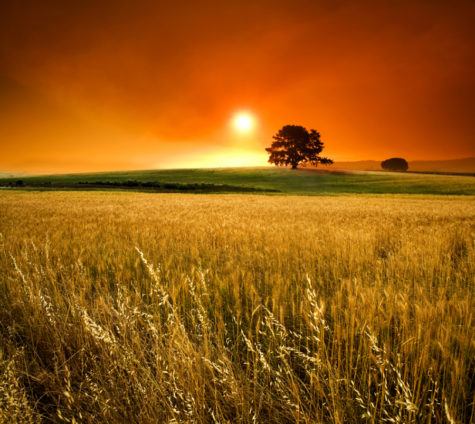
In many cultures around the world, staple crops such as corn and rice are believed to embody a spiritual essence.
In European cultures, a corn doll was often used to represent the spirit of the harvested crops. However, Europe didn’t have a monopoly on this at all. In South American countries, some tribes took the largest portion of the crops — typically maize — and dressed it in clothing as an effigy.
In Peru, people honored different spirits of the crops. The Maize Mother was the zara mama, the spirit of quinoa was known as quinoa mama, and everything from the cocoa tree to the lowly potato had a life essence.
In North America, the native tribes grew corn, or maize, as a staple part of their diet. Some groups have stories of rebirth and regeneration, and a few have folktales that parallel the story of Demeter and Persephone. In the southwestern part of the United States, Native Americans still perform a ceremonial dance that honors the harvesting of the maize every fall.
It’s not uncommon to find spiritual connections to agriculture. The Malay people of Indonesia believe that rice plants — again, a staple crop — possess a soul or life force just as humans do. Harvesting is even done in a way that is seen as “painless” to the rice plants, so that it will not suffer. In some parts of the Malay Peninsula, there is a big ceremony at the beginning of each harvest, in which a complex ritual is performed that identifies the mother of the rice soul in the selected sheaf.
Folklorist Sir James Frazer makes mention in The Golden Bough of the global phenomenon of the honoring of the spirit of the grain. He says that the mere fact that underdeveloped, primitive cultures honor a “corn mother” archetype indicates that this has been going on for thousands of years. In other words, because these cultures are “unspoiled” by modern society, their worship of such an embodiment of the grain is probably very close to the original ritual and ceremony.
Article by: Patti Wigington
August, originally called Sextilis by the Romans, was later named Augustus in honor of Augustus Caesar. Gathered harvests were celebrated in many lands during this month.
August 1st was a Celtic feast called Lunasa or Lughnassadh, meaning the celebration of harvest and new grain for bread. In Old English this became Lammas, or “Loaf Mass.” The Romans also had a harvest festival during this month, that of the Consualia when sacrifices to Consus were made. Consus was the god of the underground storehouse where the grain was kept.
They also celebrated the Opseconsiva, a harvest festival for the goddess Ops. Wine and freshly baked bread were placed on her altars. Near the end of the month they had a thanksgiving feast called the Charisteria.
At three times during August, the Romans honored the god Vulcan: on August 17 at the Portunalia; on August 27 at the Volturnalia; and again on August 23 at the Volcanalia. this last festival was held outside the city boundaries and was to ward off accidental fires, a real threat in such closely-packed and fire-prone towns. Vulcan was not the only deity honored during these festivals. The goddesses Juturna (deity of fountains) and Stata Mater (who put out fires) were invoked as a counterbalance to Vulcan’s fires – volcanoes or otherwise.
The very early Greeks had a holy day for Hecate the Dark Mother on August 13, and ten days later one for Nemesis, the goddess who balanced the scales of justice with rightful revenge and punishment. In Rome, women who had prayers answered by Diana and Hecate marched by torchlight to the temples of these goddesses. There they held a special ceremony for women only and gave thanks.
The Egyptian Blessing of the Boats is quite similar in nature to the Roman festival of the Ludi Piscatari in June during the Mead Moon. Each boat was considered to have its own personality and a need for protection and blessing. The same can apply today to cars, boats, bikes, motorcycles, and in fact to any form of transportation upon which one relies.
In India today, the Hindu people still honor the elephant-headed god Ganesha, the deity who removes obstacles and brings good luck. Flowers and dishes of rice were set before his statues. However, it is considered unlucky to look at the Moon during this festival.
Yapaquix (Sowing Month), also known as Chacra Ayapui or Capac Siquis, was celebrated by the Incas. The people of Tibet had only one major holiday this month, the Sikhim festival of the birth of Padmasambhava.
From: Moon Magick
In the English region of East Anglia, those who continue to follow the ancient ways believe that June 29 is the prime day of the year to harvest herbs for healing use.
Here are some great tips for harvesting herbs:
For the highest quality, herbs should be harvested before the Sun gets too high in the sky. The heat of the Sun will evaporate the essential oil from the herbs, so picking earlier in the day (like by 10:30am) ensures that the highest amount of oils will still be present within them.
When getting plants from the wild, respect the area and plant you are harvesting, never strip a plant bare, never pull it out by the roots to get a few leaves and I always check to see that there are other plants of the same species around and its not some rare almost extinct plant. Also be very sure that the plant you are about to pick is what you think it is, Mother Nature can be very tricky sometimes, and 2 seemingly identical plants can have very different effects when ingested. It is best to ask permission of the plant before taking it’s bounty, and remember, respect, respect, respect!
Transporting your herbs must be done carefully to retain their valuable powers. It’s best to take an open-topped basket or cotton bag with you and some layers of tissue so that herbs can be transported dry and safe back to home, it is pointless seeking out a special plant, than sticking it into a carrier bag in your pocket so it sweats, bruises and it unidentifiable mush by the time you get home.
It is best not to harvest any herbs that have been growing close to the road as the leaves take in the carbon monoxide and poisonous fumes given out by the traffic and take it down into the plant to the root where it becomes stored. Do not pick wild herbs and plants from verges or thoroughfares as this contravenes several laws and also the fact that most areas like these are open to our friendly dog and cat population.
If harvesting wild plants leave a large amount of flowers, seed and root as the plant population of that area will very quickly die out if you go in mob-handed and wrench up the only two plants for miles around.
To harvest herbs in a magickal way visit this post: Harvesting Magickal Herbs in a Magickal Way
